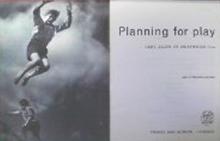
Lady Allen of Hurtwood, noting that concerning play there was “a wealth of experience, but little informed, published material,” wrote Planning for Play in 1968 to assist those architects, planners, and leaders “determined to break away from the sterile barrack-type of playground of asphalt and mechanical equipment.” Through a discussion of incidental play, group play, adventure playgrounds, play parks, neighborhood playgrounds, and hospital play needs, Lady Allen sought to “explore ways in which, through play, the inherent curiosity and natural gaiety of children can be stimulated and kept alive.” She also explored the play needs of “handicapped, subnormal and maladjusted children.”1
As vice president of the Institute of Landscape Architects and of the Nursery School Association of Great Britain and Chairman of the London Adventure Playground Association and of the Holiday Club for children with disabilities, Lady Allen understood the needs of all children for play and the challenges of designing play spaces.
She maintained that for children and young people play “is an expression of their desire to make their own discoveries in their own time and at their own pace.”2 Children want to manipulate resources to build dens, houses, and bonfires; to care for pets and gardens; and to dig and explore. In such free play they face and overcome risks and in the process develop “independence, self-reliance and (the) ability to live on their own inner resources.”3
The difficulties arise in the gap between what is important to children and what adults value. Lady Allen explained that children's play activities are “delightfully messy occupations and they make the planners, who are mostly tidy-minded, unhappy. But they must never forget that children enjoy chaos and make their own order out of it. Children enjoy being dirty and untidy; most adults hate it. We have to decide whether we are to make playgrounds for children or playgrounds that please the grown-ups.”4
Throughout Planning for Play, Lady Allen's discussion of different play plans is underscored by 176 photos and detailed plans of play spaces incorporating the best ideas of play design.
In the Incidental Play chapter, Lady Allen recognized that children “play whenever they move,” and therefore maintained that planning for their play involves considering the whole environment in which they live. Walkways, seating areas, steps, walls, balconies, and play decks are some of the features planners need to design with children in mind.
As a Fellow of the Institute of Landscape Architects (FILA), Lady Allen also discussed professional concerns with Seclusion and Scale, Ground-shaping, Surfacing and Texture, Sand and Water, Planting, and Maintenance. Many of these concepts are further explored in a later chapter on Neighborhood Playgrounds in which four successful play areas are spotlighted.
The Group Play chapter is focused on organized play situations such as in Nursery Schools, Play Groups, and One O'clock Clubs, which are afternoon park activities for preschoolers and outdoor restorative time for their mothers. In two later chapters, Lady Allen discussed the importance of play for two other groups: children in hospitals and children with disabilities.
The frightening environment of the hospital means that children have a vital need for “the right kind of play, so that (they) can gradually externalize (their) fears, slowly accept them, and adopt them to suit (their) private personal requirements.”5 The physical and emotional needs of children with disabilities are also met with outdoor play, especially in the more self-directed, but monitored freedom of the adventure playgrounds.
The majority of the book discusses the Adventure Playgrounds and their close cousin Play Parks. Lady Allen, who named this new genre of playgrounds when she brought the idea from Copenhagen-Emdrup, had previously written Adventure Playgrounds and Play Parks. In Planning for Play, she outlined the importance of the freer format of adventure playgrounds, the necessity of a playground leader, and the role of the organizing committee. Details on the site requirements are given as well as four examples of functioning adventure playgrounds.
Play parks are tamer versions of adventure playgrounds which are incorporated into existing city parks. Lady Allen explored this play option through detailed descriptions of play parks in Stockholm, London, Numeaton, Bornholm, and New York City.
Planning for Play concludes with the comment on the unevenness of play opportunities for children. In some areas there may be a dearth of play areas while other areas have a “wasteful overlapping” of play areas.6 While she advocates play space surveys and plans for play spaces near all children, she also pled with planners to create “sympathetic environments” where the play areas fit the children's needs instead of the reverse condition that is more often employed.

